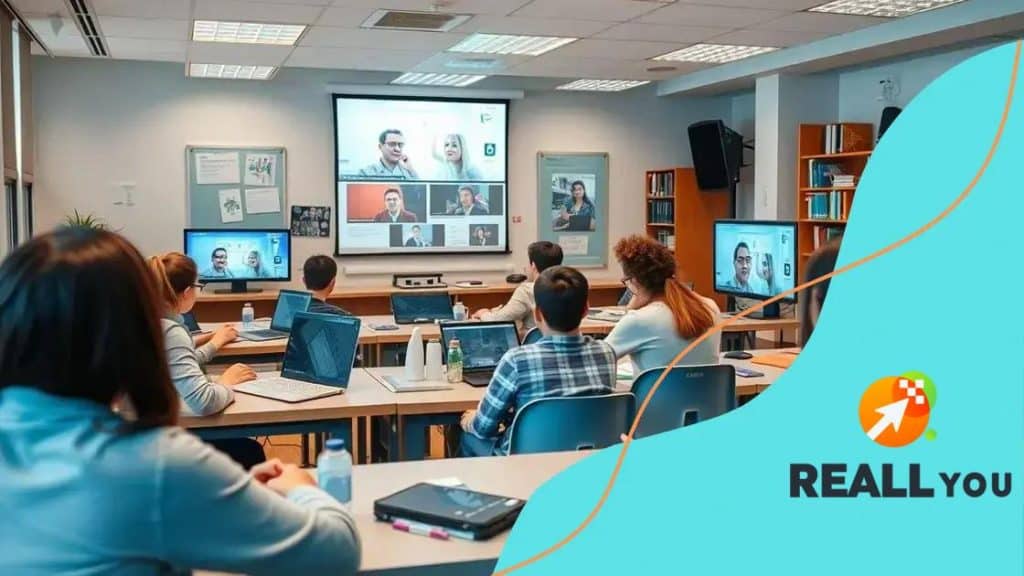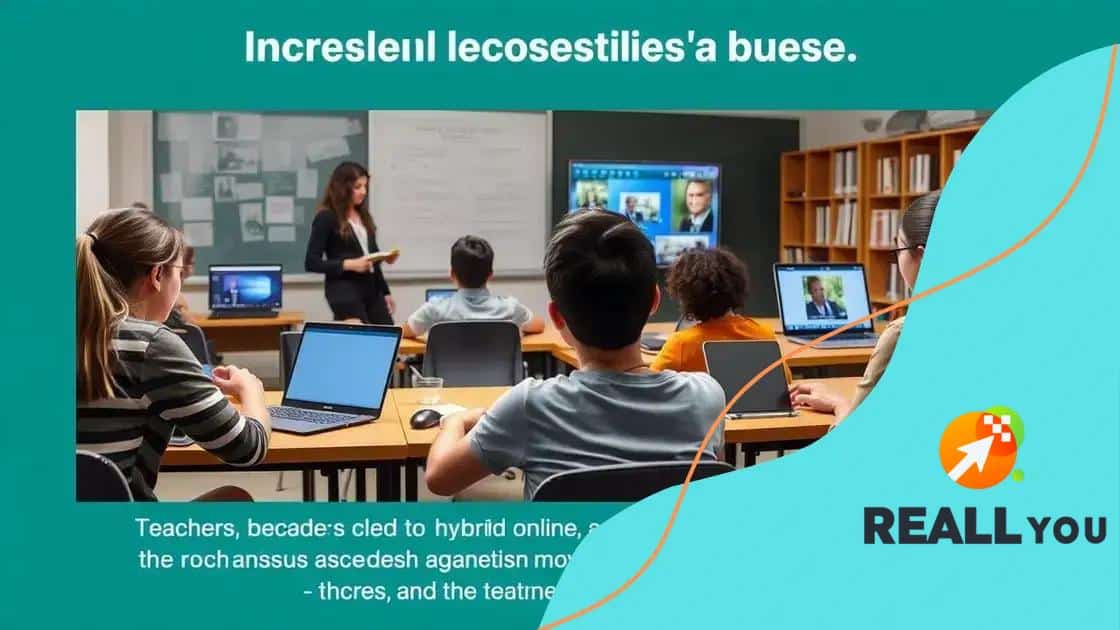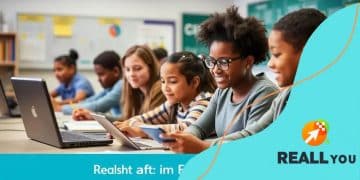The future of hybrid classrooms: pros and cons

Anúncios
The future of hybrid classrooms combines in-person and online learning, increasing flexibility and personalizing education while addressing challenges in technology access and teacher training.
The future of hybrid classrooms is shaping the way we think about education today. Imagine a blend of online and in-person learning that maximizes engagement. Curious about how this impacts students and teachers?
Anúncios
Understanding hybrid classrooms
Understanding hybrid classrooms is essential in today’s evolving educational landscape. This model blends traditional face-to-face teaching with online learning, allowing for greater flexibility and accessibility.
Anúncios
The key benefit of hybrid classrooms is that they cater to various learning styles, facilitating a more personalized approach. Students can engage with materials at their own pace, while teachers can offer tailored guidance based on individual needs.
Benefits of Hybrid Classrooms
There are several advantages to this learning approach:
- The flexibility to attend classes remotely or in person.
- Increased engagement through interactive online tools.
- Access to a wider range of resources and materials.
Moreover, hybrid classrooms can enhance collaboration among students. With technology integrated into learning, it fosters a sense of community, even if students are not physically present together. This model promotes teamwork and communication, skills vital in today’s digital age.
Hybrid classrooms also prepare students for future work environments. As more jobs require remote collaboration, learning to navigate digital tools is indispensable. Ultimately, understanding this educational approach is crucial for both students and educators.
Advantages of hybrid learning environments
The advantages of hybrid learning environments are transforming the way students and teachers interact. By combining online resources with in-person instruction, this model offers unique benefits that can enhance the educational experience.
One clear advantage is the flexibility in learning. Students can choose to attend classes virtually or in person, enabling them to tailor their education to fit their needs. This flexibility can be especially helpful for those balancing other commitments, such as work or family responsibilities.
Engagement and Interaction
Hybrid environments also promote higher levels of engagement. With access to a variety of digital tools, students can participate in interactive lessons that keep them interested and motivated.
- Access to diverse resources: Students can utilize videos, podcasts, and other digital content.
- Increased collaboration: These environments foster teamwork through online group projects.
- Real-time feedback: Teachers can provide immediate assistance to students, enhancing their learning experience.
Additionally, hybrid learning prepares students for future careers. As workplaces increasingly adopt remote collaboration tools, having experience with these technologies is essential. Students become adept at using online platforms for communication and project management.
Ultimately, the advantages of hybrid learning environments are significant. They provide a more personalized approach to education, making it easier for students to succeed and adapt in a fast-paced world.
Challenges faced by hybrid classrooms

Challenges faced by hybrid classrooms can significantly impact the learning experience. Although this model offers flexibility and innovation, it comes with its own set of hurdles that educators and students must navigate.
One of the primary challenges is ensuring that all students have equal access to technology. Not every student has the necessary devices or reliable internet at home, which can create disparities in learning opportunities.
Teacher Training
Effective implementation of hybrid classrooms requires proper training for teachers. Educators may not be familiar with all the online tools available, leading to inconsistent teaching methods.
- Time management: Teachers often need to prepare two sets of materials for in-person and online students.
- Engagement difficulty: It can be challenging to keep both in-person and remote students engaged simultaneously.
- Assessment issues: Evaluating student performance fairly across different formats can be complicated.
Another significant issue is maintaining student motivation. When students attend part of their classes virtually, they may feel less connected to their peers and teachers. This separation can lead to decreased participation and focus during lessons.
Moreover, hybrid classrooms can create logistical difficulties. Coordinating in-person and online schedules can be complex, especially in larger school systems. Finding the right balance between both environments is essential for success.
Best practices for effective hybrid teaching
Best practices for effective hybrid teaching can make a significant difference in student learning outcomes. By combining in-person and online methods, educators can create a rich learning experience that meets diverse student needs.
One key practice is to establish clear communication channels. This allows students to easily reach out for help, whether they are attending classes online or in person. Regular check-ins can also help foster a sense of community among students.
Engagement Strategies
Engagement strategies are vital in hybrid classrooms. Teachers should incorporate a mix of activities that appeal to both online and in-person learners. Examples include:
- Interactive polls: These can be conducted using virtual tools to gather real-time feedback.
- Group projects: Encourage collaboration to build teamwork skills.
- Multimedia presentations: Utilize videos and interactive content to enhance learning.
Additionally, providing flexibility in assignments can cater to various learning styles. Consider allowing students to choose how they demonstrate their understanding of topics, whether through written reports, video presentations, or creative projects. This choice can boost motivation and ownership of learning.
Utilizing technology effectively also plays a crucial role. Platforms that support both synchronous and asynchronous learning can help streamline the teaching process. Tools for organizing assignments and tracking progress can keep students engaged and accountable.
Future trends in hybrid education
Future trends in hybrid education are shaping how we think about learning and teaching in a digital age. As technology advances, these trends promise to enhance educational experiences for both students and teachers.
One emerging trend is the increased use of artificial intelligence in classrooms. AI can personalize learning experiences by analyzing student performance and suggesting tailored resources. This can significantly improve understanding and retention of information.
Integration of Virtual Reality
Virtual reality (VR) is another exciting development in hybrid education. This technology allows students to explore immersive environments from their homes. For example, they can take virtual field trips to historical sites or conduct simulated science experiments, enhancing their learning.
- Blended Learning Models: Schools may adopt more blended models, combining synchronous and asynchronous learning to suit student needs.
- Increased Collaboration Tools: Enhanced tools for collaboration will allow students to work together seamlessly, regardless of their location.
- Focus on Soft Skills: Future education will emphasize skills like adaptability and communication as students navigate both physical and digital learning environments.
Moreover, the rise of gamification in education encourages engagement through game-like elements. This approach motivates students by incorporating rewards and challenges into their learning experiences. Students are more likely to stay focused and excited about their education with interactive lessons.
As education continues to evolve, staying informed about these trends will be essential for teachers and students alike. By embracing these changes, the hybrid education model can offer a more effective and enjoyable learning experience.
FAQ – Frequently Asked Questions about Hybrid Classrooms
What are hybrid classrooms?
Hybrid classrooms combine in-person and online learning experiences, allowing students to attend classes either physically or virtually.
What are the main advantages of hybrid learning?
Hybrid learning offers flexibility, personalized learning paths, and diverse educational resources that can enhance student engagement.
What challenges do teachers face in hybrid classrooms?
Teachers may struggle with technology access for all students, managing engagement between in-person and online learners, and requiring additional training.
How can I improve my participation in hybrid classes?
Stay engaged by actively participating in discussions, collaborating with peers, and reaching out to teachers for support when needed.






